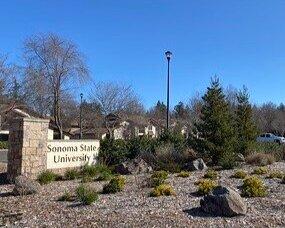Sonoma State University has a steadily growing budget deficit. As of 2021-22, according to the budget report, the deficit is $11-22 million. The school has faced the COVID-19 pandemic and decreasing enrollment in the last few years, which are both contributors to lowering funds, but it would be ignorant to assume that a deficit this large is strictly the result of lowering enrollment and the pandemic. There is a structural issue when it comes to funding at Sonoma State that has led to a continually increasing deficit, which has been growing since well before the pandemic started.
Additionally, a lack of transparency on the university’s spending has become an issue. As budget cuts increase and students are affected by the lack of funding at SSU, students are questioning where their money is going. An $11 million deficit doesn’t just happen overnight, and many are curious as to how the school has let the deficit become so large.
Assistant Vice President for Strategic Communications Julia Gonzalez stressed that the university is working to fix the deficit and said, “It is crucial to understand that this is a structural deficit. Although the one-time solutions will resolve the deficit this year, the University will continue to carry the base deficit each year until long-term structural solutions are identified…The President’s Cabinet and the President’s Budget Advisory Committee (PBAC) are beginning work to resolve the base deficit beginning in the 2022-2023 year.”
Students pay thousands of dollars to attend SSU, but don’t necessarily know where all that money goes. Three of the four students that commented on this issue felt they weren’t well informed on the university’s financial situation, and two students said they would want more specific information on university spending, in general. Nicole Jester, a fourth year art major said she is especially curious about where her tuition money is going when the school isn’t completely reopened and a lot of students are still remote.
Fourth year Psychology major and former Peer Mentor Cory Coleman was sympathetic to the school’s position, noting that COVID-19 hit SSU hard. He said, “I’m also thinking from the perspective of the school…they’re doing so badly right now. I’m sure [students] would like [specific information], but right now…is like the least favorable time for [the school] to want to share information.”
On top of student tuition and fees, SSU gets a portion of the millions of dollars in state and federal funding the CSU system receives every year.
In fact, according to a memorandum written in February from Vice President for Business and Finance Joyce Lopes and Senior Director for University Budget and Planning Laura Lupei, “the state legislature.. restore[d] the $299 million that was cut from CSU budgets last year. This plan was announced as part of a $9 billion COVID-19 relief package for California.” The funding was reinstated for 2021-22. The school is receiving a healthy amount of funding from the state for the COVID-19 pandemic, so, the pandemic should not be a main contributor to the budget deficit. There is another underlying issue.
The memorandum goes on to explain that this funding would help reduce the current deficit from “just over $15 million plus additional expenditures for initiatives to achieve our priorities… to $9.2 million.” The question remains, why would the school ever allow the deficit to get that high in the first place? Where is the accountability in the school that allowed this to happen at the expense of students and faculty members?
As Gonzalez bluntly put it, “Deficits lead to reduced spending.” This makes sense, but then what is being cut? Any student who wants to know where their money goes should easily be able to find it, and it’s just not that easy to find specific information.
Although the university budgeting office provides a budget report on their website, when reading through it, more questions than answers are brought up. For example, the President’s office received $3.5 million in funds this year, or 2% of the university’s budget, but there’s no explanation on their website as to what exactly that $3.5 million pays for. It just says “President’s Office” when reading through the report.
That doesn’t feel like transparency – there’s no real information for students to go off of. The report is too general, and no specific information on why that office needs so much money is provided in the report. Students deserve to know, and deserve to have specific information easily accessible to them. Without that, the school isn’t being held accountable, which may be one of the many reasons for the growing deficit in the first place.
While he was sympathetic to the school’s perspective on this issue, Coleman said, “I would personally value detailed information if they’re going to provide it at all, I think information is useless unless you have it detailed.”
Art Department chair Christine Renaudin explained how “reduced spending” affects her department.
“Students have less flexibility to complete their coursework and have to pay attention to stricter course rotations. We have had to stack classes, offering intermediate and advanced levels combined. We have not been able to hire new faculty to replace the recently (or not even so recently) retired faculty, which results in overwork for the remaining full time faculty members, who have to shoulder all services, including advising, and committee work,” she wrote in an email.
“The students suffer because classes they need to graduate may be cancelled for lack of funds. The full time faculty suffers from additional work trying to make ends meet for students in need of extra units to graduate. So far, independent studies have not been compensated,” she continued.
Associated Students VP of Finance Justin Arenson said, “Any budget deficit is going to require the university to have serious dialogue about its priorities and options going forward. However, Associated Students is committed to make sure the student voice is very much involved in those discussions.”
Regardless, the deficit is a systemic problem that affects students and faculty, and has affected them for years. It’s difficult as a student to be left with so little detailed information regarding university spending.
“From my point of view, as a long-time chair, the budget deficit at SSU is chronic, with some years better than others. I know a lot of the recent deficit has to do with a decrease in enrollment, but we have suffered from lean years for a long time now,” wrote Renaudin.
With a looming budget deficit of $11-22 million, it will be interesting to see how the SSU plans to correct it in the coming years.





![[Both photos courtesy of sonoma.edu]
Ming-Ting Mike Lee stepped in as the new SSU president following Sakakis resignation in July 2022](https://sonomastatestar.com/wp-content/uploads/2024/04/CC4520AB-22A7-41B2-9F6F-2A2D5F76A28C-1200x1200.jpeg)


























